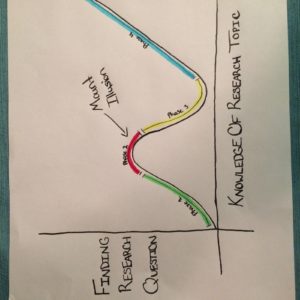Since the day I learned how to write a research paper, I always assumed I needed to use the same research question throughout my project. To me, the question seemed to be the metaphorical guiding light in the darkness of independent work, the go-to reference for determining what information is relevant or what can be put aside. It wasn’t until I started conducting my own study that I realized my initial assumption was wrong. It turned out that the more I learned about my topic, the more I learned about what I actually wanted to figure out. In hindsight, I now see that my search for a research question followed the path of Mount Stupid, or as I’ve renamed it, Mount Illusion.

For those who are unfamiliar with this comic, Mount Stupid is a graphic that originally appeared on Saturday Morning Breakfast Cereal. The comic is an illustration of a chart in which the x axis measures one’s knowledge of a topic and the y axis measures one’s willingness to give his or her opinion on it. The small hump in the middle of the graph is called Mount Stupid, otherwise known as the place where people who think they know a lot about a topic are actually not that knowledgeable on the subject.
In my case, I’ve repurposed Mount Stupid so that the y axis measures how close I was to finding my research question and the hump, Mount Illusion, measures when I believed I finally found it (needless to say, I was wrong). As the illustration above shows, I didn’t actually find my question until I was well into the research process. Here’s how I finally figured it out:
Phase 1: Stuck in the Complex
At the start of my independent work, the first thing I did was, unsurprisingly, develop a research question. Using the minimal preexisting knowledge I had on my topic, I filled in the Magic Research Statement and came up with the following question: How does femvertising (i.e. ads featuring elements of female empowerment) impact the depiction of female identity in commercials? Feeling pretty confident in my decision, I found the task to be relatively easy and I was ready to start searching for answers. That was until my adviser told me to rewrite the entire question.
Phase 2: Peak of Mount Illusion
As my adviser put it, my research question was too complex and needed to be phrased in a way that even a five year-old could understand. So, I did some more background research on feminist advertising and went through my ideas again. I then came up with a revised question: How does product-type influence the feminist aspect of commercials targeting female audiences? At this point, I was at the peak of Mount Illusion, certain that I had found my final research question. It wasn’t until I started analyzing commercials, however, that I realized this assumption was misguided. The new research question still didn’t fit with what I wanted to learn about femvertising, which meant that I needed to keep working on it.
Phase 3: Wandering in the Dark
Having already spent too much time thinking about it, I decided I needed to set my research question aside and to just blindly navigate my data to see what I’d find. Despite not being able to articulate the main focus of my research, I figured I would at least know what I was looking for once I saw it. As it turned out, the more I analyzed the slogans, scripts, and images of women in the commercials, the closer I came to finding my research question.
Phase 4: Age of Discovery
Weeks into going through my data, I finally understood that my previous research questions didn’t work because they were too specific and trying to encompass too many ideas. While talking through my study with my adviser again, it became apparent to me that my question could be broadened to incorporate the various elements of my study. As a result, I was able to reformulate my research question as the following: How feminist are the ads that promote female empowerment? Luckily, I didn’t need to make any more changes from this point on.
Reflecting on my experience helped me to realize that it’s hard to stick with the same research question, especially when you’re still unsure about what you’re trying to find. I also now see that revising the question can in fact be a good thing; if it hadn’t been for making changes while going over Mount Illusion, I wouldn’t have found my final question. In this way, a research question doesn’t have to be a static guideline throughout your study; it can be an evolving entity that gets clearer when you learn more about your topic. So, if you find yourself worrying about your research question or still feeling like it’s not quite right, know that you’re not the only one and that you can definitely discover it as you go along.
–Taylor Griffith, Social Sciences Correspondent

